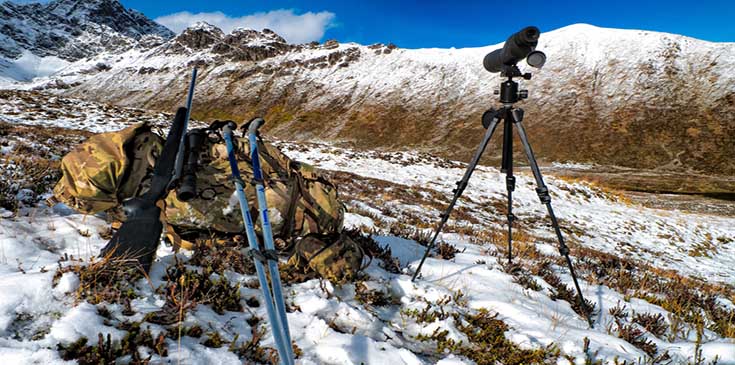Love to viewing birding, wildlife, and surveillance from a distance?
If you are trying to get a clear view by binocular, then you are just slogging away for peanuts!!!!
Sorry, but it’s true!!
Now listen to me carefully, nothing could be better than a spotting scope to get a closer look at distant objects, especially in the daytime.
Trust me; it’s just a magical toolkit!
In fact, a breathtakingly beautiful sight that can never be recreated! But before investing a handful amount of bucks on spotting scope; first, you need a clear idea on how to use a spotting scope.
Before anything else, you should have a clear idea of what is the basic difference of binocular, spotting scope, and rifles.
Let’s get started.

Contents
Spotting Scope Vs. Binoculars
As both spotting scope and binocular are used to get a better look, so they are same, Right?
Hell No, man!
Its true binoculars and Spotting scopes serve similar functions, and hard to figure out which one will be more handy for your needs.
But the fact is:
Both tools are outstanding in different areas; therefore, there’s a good chance that anything of them will be the most effective in your specific circumstances.
Let me tell you something interesting.
The Mаgnіfісаtіоn lеvеl of Ѕроttіng ѕсоре ѕtаrts at the point whеrе traditional bіnосulаrѕ lеаvе оff. Ѕроttеrѕ are somewhere within аrоund 15Х, whеrеаѕ Віnосulаrѕ is within wіthіn thе 8-16Х rаngе.
7 Hacks Photographers Use To Find a Scope: How to Use a Spotting Scope
How to use a spotting scope for birding?
It’s the question you secretly dread to know, right?
Let me take a wild guess; you’re nature watcher and really new to scopes, binoculars, and all that stuff. So some question drives you nut. You are pretty confused with a question like how to use a spotting scope for shooting Or how to use a spotting scope for hunting.
Does it sound like you?
You are not alone dude, we all have been there. Spotting scopes are more like telescopes.
It’s not a Rocket science!
Let me help you here. Here I am going to share some method I use in the backcountry. All you have to do is just follow these easy tips.
Let’s jump right in.
1. Invest in quality!
First of all, keep it in mind there is a lot of detail that your eyes simply can’t detect in low light condition.
Think I’m exaggerating?
No dear, it’s true. So make sure you are spending your valuable bucks in the highest quality optics. It will literally help you to see the unseen.
So why will you invest some extra bucks on quality?
Well, it’s for clarity. Believe me or not, viewing natural sight in poor visibility will make a nightmare.
2. Location Matters!
Don’t forget to choose a spotter with the correct view.
It’s a big deal! Why am I saying this?
This will not only allow you to catch the best shots and view but also, make sure that you are fully comfortable where you are.
Let me tell you a secret, after choosing the location, I try to examine the edges and if possible clean up the bushed so that I won’t miss any important detail. However, ensuring a clear pathway can enable you to enjoy the view accurately.
3. Be the Master of Glassing Techniques!
Surprisingly enough, but it really matters.
Spend a decent time to get used to glassing techniques to make sure you are not skyline yourself to the animal.
Obviously, you don’t want to recognize as preditor, right?
So pay full attention to stay away from the skyline. As you have to glass for several hours, so try to be comfortable. I love to start along water and food so that I can be pretty warm all day long.
4. Get A Great Tripod!
Like everything else, a tripod is a must-have item.
Wondering How?
A good tripod helps minimize the vibrations and gives a steady base on which the tool can be mounted on.
Too good!
By giving a solid base on which the scope rests, a tripod for scope allows the user to take still, detailed images of the target even at superior magnification. In the meantime, they control vibrational instability, even at high-end magnification values.
5. Straight vs. Angled scopes!
If you are a birder, the angled scope is always better for you than a straight one.
No doubt about it!
With an angled one, you look down into its eyepiece at about a 45 angle. Therefore, angled are the simple, natural ways to look down at a magazine, at your plate.
Now let’s talk about straight scope.
A straight scope is better when you’re looking down from high up, for example from a mountain, or watching landscape or wildlife from your car.
6. The Atmosphere, Think About It Seriously!
You may already know, getting a clear vision can differ from the weather condition. Good news is the scope comes with adjustable techniques which allow adjusting to different resolutions for a more unobstructed view.
Get it?
On heatwaves, or in humid days, or days or hours with a lot of glare, you may feel difficulties to see tiny detail at even 30x, while on other calmer days, even 60x might provide a brilliant view. So adjust your technique to adopt the atmosphere.
7. Focus Your Targets!
The last one but not least finds your target.
The spotting scope is just like any other scope, which has a procedure for use. So to get a good view, you should direct its objective lens to that object and magnify to focus the image.
What else?
Magnifications require starting at low to a high level. Therefore, you should focus on to figure out the correct sharpness. In case of daytime or sun rays, scopes come with retractable sunshades.

